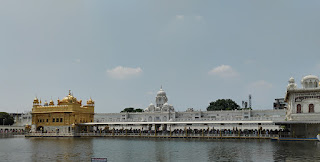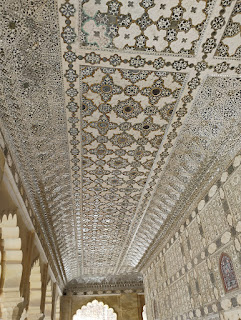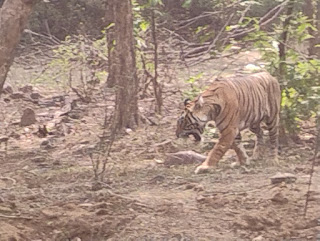After an overnight stop in Delhi, we boarded a train and headed up to Amritsar. We had a brief walk around when we got there, mainly just to stretch our legs having been on the train for over 6 hours.
Wednesday, 25 June 2025
India - week 9
Tuesday, 17 June 2025
India - week 8
We've certainly covered some ground this week, 1,580kms by train, plus assorted tuk tuks and safari jeeps, and packed a lot in.
From Udaipur we headed further north to the pink city of Jaipur, and the temperature continued to increase to 40C+
The following morning we visited the Hawa Mahal, also known as "palace of winds" which is part of the City Palace complex. It was built in 1799 and has over 900 small windows decorated with intricate latticework over 5 levels. It was designed so that the royal ladies could observe everyday life and festivals celebrated in the street below without being seen. The many windows also allowed cool air to pass through and so making the whole area more pleasant during the high temperatures. The familiar view is actually the back of the building.
Here is a picture downloaded from Wikipedia,
however, the gods of scaffolding frowned on us once more and this is what we saw
Here are a few photos of the inside.
A short walk around the corner was the City Palace, our next stop. As the Jaipur royal family are in residence there, the ticket prices for foreigners were extortionate, so we chose instead to see the various buildings and museums that are part of the complex.
Here are just a few photos
These vessels are believed to be the largest silver ones in the world. They were crafted to hold holy water from the river Ganges, hopefully without added body.
They each weigh 345kg and can carry approximately 2,000 litres and were used by the Maharaja to carry water to England in 1902 to attend the coronation of King Edward VII.
That evening we headed to the Amber Fort, also called the Amer Palace, to watch the light show from a rooftop restaurant. We couldn't quite hear the narrative but it was nice to see anyway.
The next day we visited Panna Meena ka Kund, a beautiful stepwell constructed in the 16th century and one of the hundreds of ancient stepwells that still exist in India. They were often constructed just outside towns and villages to provide local people with water for drinking, bathing, washing clothes and irrigating crops.
Before it got too hot we went back to the Amber Fort, another UNESCO world heritage site, walked up to and around it. Constructed of red sandstone and marble, the palace is laid out on four levels, each with a courtyard.
This was the Sheesh Mahal, the mirror palace.
We never get a guide as we prefer to see things at our own pace and read the various descriptions. We were wandering around the king's bedroom when a security guard called us over and took us through a closed off restricted area. He showed us a Persian water wheel, clay pots on an endless rope belt driven by men which lifts water up to 20m. The palace has a chain of three or four of these to get water all the way from the lake to the top floor. He told us to look down the enclosure where we saw hundreds of sleeping bats.
He also showed us a few more closed off rooms and passages, so in the end, we had an unofficial guide for a short time.
On the way back to the hotel we stopped briefly to view the Jal Mahal also known as the Water Palace as it's located in the middle of Man Sagar Lake. The palace looks like it's floating on water as its a five-story structure, with four floors submerged underwater.
Later that afternoon we visited Birla Mandir also known as Lakshmi Narayan Temple. It's is a modern Hindu temple built in 1988 and is known for its all-white marble structure and intricate carvings.
From there we headed to Patrika Gate, an entry to Jawahar Circle Garden. It was made of pink limestone and has beautiful murals, designs, and frescoes on each pillar and arch.
The following day saw us on a train once more, this time heading down to Ranthambore National Park. The park is huge and covers a total area of 1,334 km2. It was originally established as a game sanctuary in 1955, then a Project Tiger reserve in 1974 and is known for its Bengal tigers. There are ten zones and we did a total of three safaris. We were lucky enough to see tigers on two of them and a sloth bear on the third, together with lots of other wildlife.
The first safari was in to zone 6 and we saw a tiger called Lakshmi. She was hiding in the trees and we waited to see if she would come down to the stream to drink. After a long time our driver decided to take us to look for other wildlife. When we came back a while later, she had come down to the stream to drink.
The next morning our jeep picked us up at 5.30 and off we went, this time into zone 1. The next tiger we saw was 18 years old called Noor. She was sleeping behind some rocks and her head would pop up occasionally, then go back to sleep. After a while, she'd had enough of us so she got up and walked behind a tree, then slumped down and went back to sleep.
We left her in peace and continued our search, which paid off. Not far from the gate and near a watering hole we found Sultana, Noor's daughter, and her mate Sky. We were lucky enough to get quite close so we were able to observe them for some time.
Then it was back to the hotel for a swim, lunch and relax before our final safari in the afternoon, this time into zone 10. We drove around for some time and saw lots of birds, many species of deer and antelope, peacocks, mongoose, wild pigs and more, but no tigers. Part of the zone was still closed due to a young boy being killed by a tigress a few weeks before. There is a temple near the fort in the park that many locals visit and it is thought that the young tigress, only 22 months old, might have mistaken the boy for a young deer.
On the way back to the watering hole we saw a sloth bear coming out of the trees. He looked just like a shaggy teddy bear.
The next day it was back to Jaipur to get another train to Agra.
The Agra Fort, another UNESCO world heritage site, is also known as the Red Fort and has stood on this site for many centuries. The current structure was rebuilt during the 15th century.
The Taj Mahal is only 2.5kms away
The next morning dawned very overcast so no sunrise over the Taj Mahal but we were at the western gate before 6am and the crowds.
No photos were allowed inside the mausoleum but we saw most of the area before the heavens opened an hour later. Due to the rain, many of the previously drained pools were filled so I was able to get a few really good photos.
Then it was on to Delhi for a night so we could get the train 500kms north to Amritsar.




















































































































